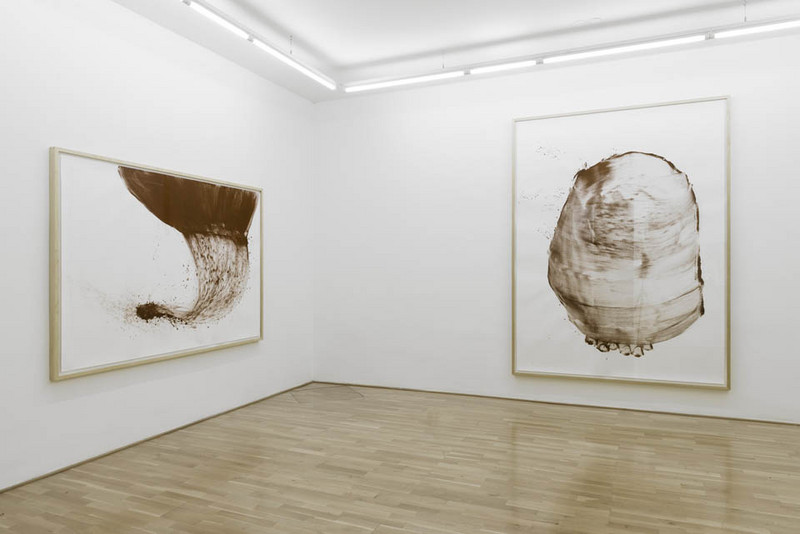Daniel Lergon
04 Sep - 05 Oct 2013

Daniel Lergon
Bagdad-Batterie - Daniel Lergon, exhibition view, Galerie Andreas Huber, Vienna, 4.9. - 5.10.2013, Photo: Georg Petermichl
Bagdad-Batterie - Daniel Lergon, exhibition view, Galerie Andreas Huber, Vienna, 4.9. - 5.10.2013, Photo: Georg Petermichl
DANIEL LERGON
Bagdad-Batterie
4 September - 5 October 2013
The Baghdad Battery is a riddle which has not been solved to this day. Some researchers speculate that it was capable of producing chemically based electricity some 2000 years ago. In the center of a clay pot there is a copper cylinder, in the middle of which is an iron rod. So the artifact is equipped with the basic elements of a galvanic cell, such as is used in conventional batteries. Nonetheless, researchers have so far not been able to provide any evidence (or traces of an electrolyte) that this object, which dates from the beginning of our calendar system, was conceived to produce electrical current.
The mysterious archaeological object, found between the Tigris and Euphrates in 1936, is the source for the name of the third solo exhibition by the Berlin-based painter Daniel Lergon (b. 1978) at the Galerie Andreas Huber in Vienna. Lergon is showing a selection of his recent cooper pictures, which bear a relation to this real existing pot. A column in positioned in the middle of a three-part exhibition space, encased in an iron primed screen, with the copper pictures surrounding. In analogy to the electromotive series of the elements, this creates a stress field in relation to the painting between the inner “electrode” and the outer ring of copper pictures. The priming of the paintings is coated with pulverized copper, and the metal particles react with acidulated water, which Lergon uses to paint with. The material begins to oxidize, determining the modulation in form and color of the image. The use of pure metal, that is, elements, in the painting process harbors a chemical potential that produces color without the usual use of pre-made pigments. The painter's reaction to the material, which is constantly reforming and reacting, becomes visible. The two exterior rooms feature large-format pictures with copper on paper.
Speculations about the potential behind an image, the process of creating an image itself, are as much present in the space as is the question of the historical finding. The narrative potential of this artifact is the vehicle for ever new speculations about the “finding” of the contents of an image through abstraction (from the Latin for separation), that is, the separation from the real object in painting.
Already in 2010, Daniel Lergon had worked with an object whose origin has provoked historical and poetic speculations, the Voynich manuscript. It is a written document, believed to have been produced in Italy in the 15th century, which no scholar has yet managed to decode.
Bagdad-Batterie
4 September - 5 October 2013
The Baghdad Battery is a riddle which has not been solved to this day. Some researchers speculate that it was capable of producing chemically based electricity some 2000 years ago. In the center of a clay pot there is a copper cylinder, in the middle of which is an iron rod. So the artifact is equipped with the basic elements of a galvanic cell, such as is used in conventional batteries. Nonetheless, researchers have so far not been able to provide any evidence (or traces of an electrolyte) that this object, which dates from the beginning of our calendar system, was conceived to produce electrical current.
The mysterious archaeological object, found between the Tigris and Euphrates in 1936, is the source for the name of the third solo exhibition by the Berlin-based painter Daniel Lergon (b. 1978) at the Galerie Andreas Huber in Vienna. Lergon is showing a selection of his recent cooper pictures, which bear a relation to this real existing pot. A column in positioned in the middle of a three-part exhibition space, encased in an iron primed screen, with the copper pictures surrounding. In analogy to the electromotive series of the elements, this creates a stress field in relation to the painting between the inner “electrode” and the outer ring of copper pictures. The priming of the paintings is coated with pulverized copper, and the metal particles react with acidulated water, which Lergon uses to paint with. The material begins to oxidize, determining the modulation in form and color of the image. The use of pure metal, that is, elements, in the painting process harbors a chemical potential that produces color without the usual use of pre-made pigments. The painter's reaction to the material, which is constantly reforming and reacting, becomes visible. The two exterior rooms feature large-format pictures with copper on paper.
Speculations about the potential behind an image, the process of creating an image itself, are as much present in the space as is the question of the historical finding. The narrative potential of this artifact is the vehicle for ever new speculations about the “finding” of the contents of an image through abstraction (from the Latin for separation), that is, the separation from the real object in painting.
Already in 2010, Daniel Lergon had worked with an object whose origin has provoked historical and poetic speculations, the Voynich manuscript. It is a written document, believed to have been produced in Italy in the 15th century, which no scholar has yet managed to decode.
